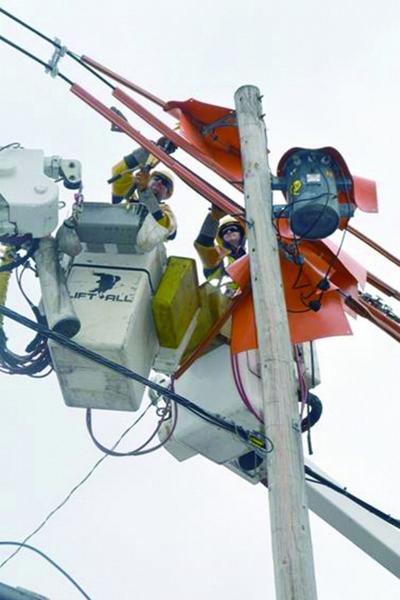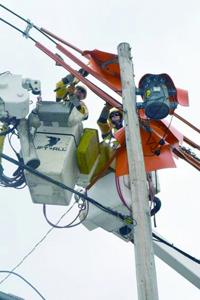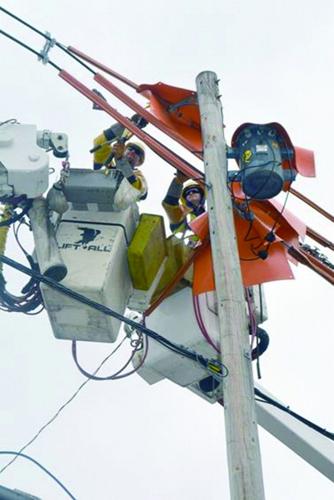Central Hudson Gas & Electric plans to challenge millions of dollars in fines related to its response to Tropical Storm Isaias this summer, a company spokesman said Friday.
The $16 million in penalties were the result of an investigation by the state Department of Public Service.
The Poughkeepsie-based company is accused of 32 violations including improperly preparing for the Aug. 4 storm and having inadequate communication with customers.
Central Hudson is one of three utility companies in the state facing fines.
Con Edison faces up to $102 million in fines for 33 violations, and Orange & Rockland Utilities faces up to $19 million in fines for 38 violations. The companies have 30 days to submit their responses to the allegations.
“We had Hurricane Isaias back in August,” Gov. Andrew Cuomo said Thursday. “We once again had delays from the utility companies. Utility companies once again said to me, ‘Oh, what can we do, we had a storm.’ I once again said we pay you to handle and be prepared for storms. That’s the essence of the agreement that we have with you. They want to say the storm is the reason why the service was disrupted. I want to say I understand that and we’re reasonable, New Yorkers are reasonable, but we’re paying you for the service of restoring power after the storm.”
Central Hudson plans to dispute the penalties, company spokesman John Maserjian said Friday.
“We are reviewing the order regarding the state’s findings on utility storm performance and the proposed penalties, and we look forward to the opportunity to show cause as to why these penalties should not be assessed,” Maserjian said. “We take our responsibility in responding to major storm events seriously, and Tropical Storm Isaias is no exception.”
The state takes the penalties seriously, Cuomo said Thursday.
“They have a right to contest. Let them contest,” Cuomo said. “We will remain diligent in pursuit of the penalties because we are serious.”
Isaias was the fourth-most severe storm in Central Hudson’s history and affected 117,000 customers — more than a third of all of the utility company’s customers. The most severely affected areas during the storm were Orange County and southern Dutchess County, Maserjian said.
“This was one of the most severe storms to impact our region, yet our restoration was completed quickly and safely, with power restored to 98% of impacted customers in three days, and our communications were robust, consistent and timely,” he said, “Central Hudson amassed a field force of more than 720 line and tree workers — one of the largest ever assembled — plus hundreds in support roles to address nearly 2,000 damage locations. As restorations were completed, we released many of these crews to other New York utilities to assist in their restoration efforts.”
Power was restored to all Central Hudson customers by Aug. 8.
If the fines are upheld, the company does not anticipate a rate increase, Maserjian said.
“Our current understanding is that those fines would not affect utility rates,” he said.
The company takes storm preparation seriously, Maserjian said.
“Central Hudson prepares for severe weather through a comprehensive tree trimming and vegetation management program, significantly expanded in the last decade, by replacing aging infrastructure with new, modern materials and implementing storm-hardening measures in storm-prone areas,” he said.
“When preparing for and responding to storms, Central Hudson also follows an electric emergency plan, which is reviewed and approved by state regulators annually, and conducts storm drills regularly to ensure readiness when storms do strike.”
Central Hudson based its planning efforts on the belief that its service territory would be to the west of the storm center, according to the report issued by the state Department of Public Service.
“Based on the low level of resources on site at the time that restoration began, it is clear that Con Edison, Orange & Rockland and Central Hudson were unable to obtain the needed resources in a timely manner,” according to the report.
Central Hudson began requesting full-time equivalents Aug. 3 — the day before Isaias hit its service area, according to the report. The company requested 100 full-time equivalents from North Atlantic Mutual Aid Group, which coordinates mutual assistance for member utilities, on Aug. 3.
The report states that only 126 workers were allocated, with about half going to utility company PSEG LI, which had requested 700 workers, and the remaining being split between Central Hudson and NYSEG, which had requested 100 workers.
“Obtaining resources prior to the storm’s arrival through North Atlantic Mutual Aid Group was extremely unsuccessful, as more than 85% of the requests remained open,” according to the report.
After the storm hit, Central Hudson requested 200 workers. Only 88 workers were assigned across the board to Con Edison, which requested 1,200; Orange & Rockland, which requested 750; PSEG LI, which requested 1,000; NYSEG, which requested 200; and Central Hudson, meaning 97% of the requests remained unfilled.
The Department of Public Service alleged that Central Hudson failed to keep its website updated for extended periods during Isaias.
Central Hudson took steps to prepare for Isaias and to communicate with customers, Maserjian said.
“Every employee is assigned a storm role to support the service restoration efforts and communicate with our customers and community leaders,” he said. “In the case of this storm, steps were taken ahead of time, before the tropical storm arrived, to prepare employees, obtain supplies, secure mutual aid crews and reach out to the community.”
The company monitors the weather forecast and participates in conference calls with the National Weather Service, other utility companies and first responders to help prepare.
“When it’s apparent that the storm will have an impact on our area, we work with a group called North Atlantic Mutual Aid Group to indicate what we believe our needs will be in terms of extra crewing and we also reach out independently to other utilities to secure additional resources and we’ll schedule those resources according to our needs,” Maserjian said.
Outside crews are paired with Central Hudson employees and assigned to restoration efforts.
“It’s a very carefully coordinated approach to repairing the damage in a quick and safe manner,” he said. “Safety is very important when it comes to restoring power on a mass basis.”










